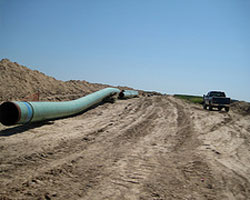Concerns Grow Over Spills to Come
 © Shannon Patrick/Flickr
© Shannon Patrick/Flickr
A “worst-case-scenario” report released this month has raised new questions over the safety of the proposed Keystone XL pipeline that would carry hundreds of thousands of barrels of tar sands oil into the U.S. from Canada. Going against estimates released by the pipeline operator, TransCanada, the new report found that a “worst-case-scenario” spill could release over 7 million gallons of toxic tar sands oil—or partly-refined bitumen—in the Nebraska Sandhills region, and another 5-6 million barrels at each of the three river crossings.
 U.S. Dept. of State
U.S. Dept. of StateSince last year, the State Department, which initially seemed inclined to grant TransCanada a permit for the project, has butted heads with the U.S. Environmental Protection Agency, various environmental groups, and even a few conservative Senators over the potential environmental hazards of the Keystone XL expansion project. One major issue has been over the pipeline’s proposed route, which runs from Alberta, Canada, south through the Dakotas, Nebraska, and other Midwest states, on its way to refineries on the Gulf coast of Texas. Along the way, the pipeline would cross many populated areas and several major waterways, as well as the Nebraska Sandhills, a large feeding region for the Ogallala aquifer, which provides drinking water to two million people and irrigation for surrounding farmlands. Because Keystone XL is meant to be a buried pipeline, it would lay within the aquifer itself for a stretch of its route, so concerns have been raised over the detection capacity for small leaks which could still lead to big damages.
TransCanada insists that the pipeline will be safe, estimating that about 11 “significant” spills—those leaking 50 barrels of oil or more—would happen over 50 years of operation. They also say that their teams are well equipped to handle any spills that do happen. But the new report from the University of Nebraska’s John Stansbury, associate professor and associate chair of environmental and water resources engineering, tells a different story. His “worst-case-scenario” study for Keystone XL found that TransCanada made “significant, flawed and inappropriate assumptions about the frequency and severity of expected spills from its pipelines.” In other words: spills could, and probably would, be worse than TransCanada predicts. A lot worse.
Stansbury’s study reported 91 significant spills over Keystone XL’s lifespan, versus the 11 initially estimated by TransCanada. His estimate for the response time to spills after they are detected is also pretty far off from TransCanada’s: They reported an average response time of just about 12 minutes, while Stansbury’s estimates clock in closer to two hours.
In an e-mail to E, Stansbury said that any company is bound to downplay the risks involved in their projects. “I think that all of us try to present our operations in as good a light as possible,” he wrote. “TransCanada used assumptions in their assessments that tended to minimize resulting impacts. That is something everyone would do. I tried to use assumptions that I considered unbiased and more appropriate for a worst-case analysis. I’m sure different people will disagree with some of my assumptions.” Those assumptions included data from past spill scenarios which TransCanada’s report has omitted for various reasons—like past spills with no official identified cause, he said.
Perhaps unsurprisingly, TransCanada does disagree with Stansbury’s findings. They issued a response to his study on Monday that rebuffed many of his claims. “As a pipeline operator across North America for over 60 years, safety is a top priority for TransCanada,” wrote Terry Cunha, spokesperson for the company. “We would not put our reputation or the public at risk by doing the things that [this new] document…suggests.” But Stanbury said that he doesn’t mean for his study to be presented as a definitive portrait of what will happen with Keystone XL; he only wants to offer an alternative view of what could be possible.
“The bottom line is that the assessment of potential impacts from the pipeline had not yet been adequately conducted,” Stansbury wrote. He added that if government officials only went on previously existent documents, including TransCanada’s assessment, “they would develop an unrealistically rosy view of the pipeline’s potential impacts.” He said he hopes his findings will reach key decision-makers and help them make a more informed conclusion over the Keystone XL pipeline project.

